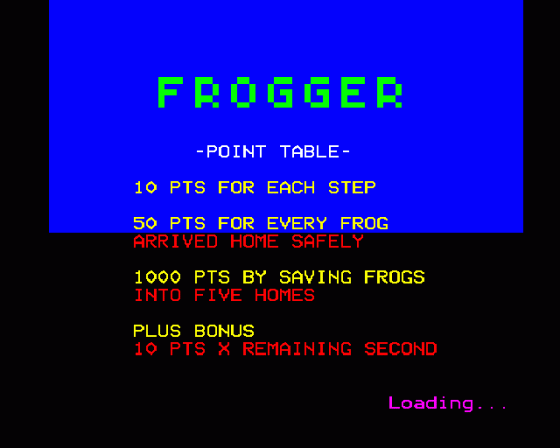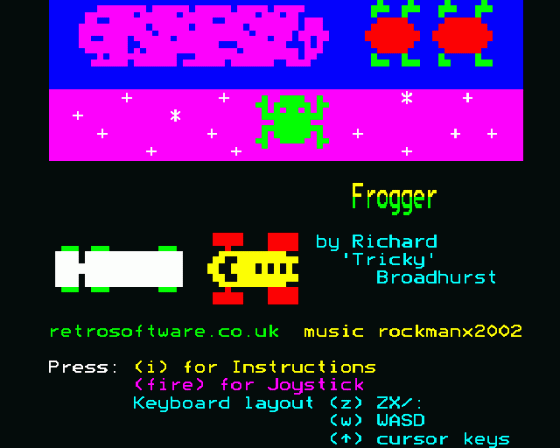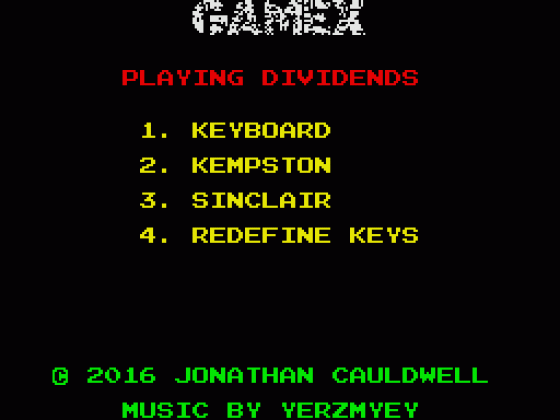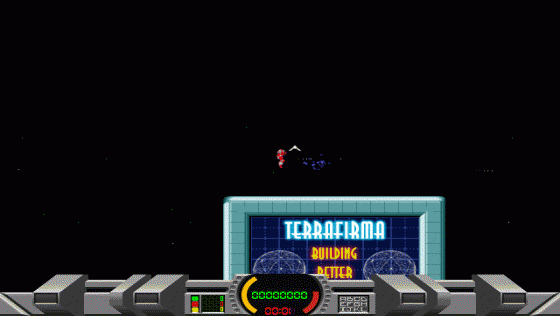
Micro Mart
 21st April 2016
21st April 2016
Categories: Review: Software
Author: Dave E
Publisher: Mezei Robert
Machine: Spectrum 48K/128K
Published in Micro Mart #1410: April 2016 Special
Dave Edwards, the man whose life is retro, fires up another selection of brand new games on obscure, and not-so-obscure, formats... including a first for the column in the form of a retro PC title
Introduction
Welcome to another Retro Round Up, where I take a wander around cyberspace looking for the best (and occasionally worst) of the newly-released games for the formats of yesterday.
This month, we have, in my opinion, one of the most interesting selections yet - as the games featured all, to a greater or lesser extent, converge the modern with the retro. Frogger we all know, but how many of us would expect a MAME-quality conversion on the humble BBC Micro?; Gamex 2 is one of the first ZX Vega-specific titles to appear; Save The Trees plays like a modern day budget game and Exile 2: The Nameless is a current PC sequel to one of the most revered graphic adventures in retro gaming history. As per usual, visit the tinyUrls next to the game title for more information and/or to download the game - all those mentioned this issue are available free of charge.
Frogger (Retro Software, BBC Model B, Free, tinyurl.com/j7wzmrw)
Retro Software, which publishes games for the 1980's BBC Micro machines, has announced the release of a new version of Frogger, the Unique Selling Point of this version being how closely it adheres to the arcade original.
Obviously the BBC received its fair share of Frogger clones back in its heyday, not least of which the excellent Hopper by Acornsoft. So, at first sight, it seems an odd choice for a "new" homebrew game, because there really wasn't any demand for it.
However, to approach reviewing it in that sort of way would miss the point, for it is not the game itself which holds so much fascination here. Firstly, it is written by master Beeb coder Richard Broadhurst and, like David Boddie's Castle Raider (See MM #1350), it is a technical marvel.
Why? Well, the BBC was limited, in its high resolution mode to four colours. Will any games for the BBC that have more than four colours in that mode, please step forward? No takers, because it would appear to be technically impossible to do it. That is, until this version of Frogger came along.
Looking it in action (see screenshots), it's barely discernible from its arcade machine equivalent. From the jangly background tunes through the smoothly hopping frog to the identical "snug fit" of the final leap for home, it's breath-taking to appreciate the entire game is going on in addition to poking the BBC's graphics chip in such a way as to throw out colours and definition it was never intended, or expected, to. No doubt a project of epic proportions for the programmer, the finished game succeeds in looking nothing short of effortless.
Obviously, everyone knows how to play Frogger too.
Scores (Frogger)
Graphics 50%
Sound 60%
Playability 65%
Technical Achievement 100%
Overall 69%
Gamex 2: Playing Dividends (ZX Vega, Jonathan Cauldwell, Free, tinyurl.com/zqtbovz)
Rather incredibly, it's nearly eight years since the first release of Gamex: The Games Exchange, an interesting "compilation" idea by Jonathan Cauldwell which featured sixteen short, simple games. Gamex 2 is more of the same - that is, different games but the same idea.
You start the game with no money, playing a game called Deathcap. Fling all the mushrooms out of the playing area of Deathcap to build up your score, in the form of pounds, whilst avoiding the patrolling nasty and his bullets. Collisions will see the "tax percent" meter rise. When this hits 100% your Gamex 2 game is over.
Again there are sixteen "simple" games included, all of which are coded in machine code and are very responsive to joystick/keyboard control. Amongst them a cameo appearance by Egghead plus clones of Push The Bales, Thrust, Duck-Shoot, Skramble and Caterpillar.
The games all use the same controls and are so easy to play that they don't really require instructions. A nice feature is that the games themselves change too. I don't know if some clever coding generates elements of them pseudo-randomly or whether they choose from several different layouts but the effect is that you're never playing exactly the same game twice.
This is important because the skill of the game is in trading shares. Like the first one, you use the £s accumulated to buy shares in other games and share prices fluxuate, so that when the dividends are paid on the games that you own your £s increase and you must play that game a second, or third, etc, time. Oh, and there's no escape from a game once it's started other than to complete it. So if you can't face another game of Deathcap, you'd better junk all your shares in it or you'll risk being forced to play it again.
Personally, I wonder if anyone really plays the trading part? My interest primarily was in seeing each of the games and, after I did, I just played the ones that I liked until I had collided with the bad guys so many times that the tax rate hit 100%. I deliberately didn't read my review of the first game again before writing about the second, in case that prejudiced what I would write. But I'm sure I probably thought the same about the first Gamex too.
Rather unusually, Gamex 2 is currently only available for the ZX Vega and it didn't come preloaded with the system. So, to play it, you need to download it from the ZX Vega forums, stick in on an SD card, plug the SD card into your ZX Vega and then access it from the on-screen menu. A Spectrum version is promised soon however, and may be published physically on cassette by Cronosoft.
Scores (Gamex 2: Playing Dividends)
Graphics 68%
Sound 34%
Playability 66%
Overall 56%
Save The Trees (Spectrum 48K/128K, Mezei Robert, Free, tinyurl.com/houg7vx)
We haven't seen a puzzle game on the Spectrum for a while, so Mezei Robert's Save The Trees is a more-than-welcome new release. It's a succession of grid-based puzzles, which are not played against the clock and which steadily get more difficult.
It's simple enough to play - you have a 5 x 5 grid (so 25 squares in all) and the object is to turn any squares within that grid that are not white to white. If you believe the instructions, the grid itself is a tree and the squares that are not white are infected by grubs. The catch is that you can only disinfect an area of either 2 x 2, 2 x 3 or 3 x 3 squares, and each screen starts with different degrees of infection affecting an ever increasing number of squares.
The squares cycle from blue (most severe), through to white (disinfected). Put simply, what you don't want to do is to spray an area that ends up leaving one infected square jutting out with only white squares around it. You can't disinfect any area that includes even a single white square, so if that happens, you've definitely made a mistake and you'll need to undo that move - and possibly previously-made moves too.
And note: you don't have unlimited moves, and undoing a move also counts as one. The skill of the game is allocating you a maximum number of moves per screen. This distinguishes Save The Trees from a sort of simplified version of Mah Jong, as it demands a bit more thought before any moves are actually made.
Whether because I am a genius or just lucky, I managed to disinfect the first ten levels without a lot of brain-strain. After that, well, they got tough.
As I said, it's simple enough to play and it's fairly polished, with a loading screen and a welcome of one-channel beep music. However, I did think the colours indicating levels of infestation were somewhat ill-chosen - the Spectrum can apply a shade to each of its colours and I thought it would be inherently more logical to have colours "heat up" to show levels of infestation - i.e. dull white, light white, dull yellow, bright yellow, dull red then bright red - instead of white, yellow, cyan, purple, red then blue! It's not exactly a sequence of colour that is memorable.
A great feature is that, when you are finally defeated, you can start at that level again rather than having to play through all preceding ones. However, I found the menu that allows this a bit confusing - you have to crank up a "Set Level" to the "Maximum" then start the game in the normal way.
Written by Hungarian Mezei Robert, its instruction manual could also do with a complete rewrite.
Save The Trees won't ever be known as one of the Spectrum's greatest, but if you like simple but taxing puzzle games, you won't go far wrong here.
Scores (Save The Trees)
Graphics 30%
Sound 30%
Playability 75%
Overall 45%
Retro Find Of The Month - Exile 2: The Nameless (PC (Windows), Ovine By Design, Free, tinyurl.com/hdnjcva)
This is a first for this column - a review of a PC retro game!
Exile 2: The Nameless comes from Ovine By Design, and is written in large part by Trevor Storey, who brought us Darkness (C64, Psytronik, see MM #1346) and Soulless (C64, Psytronik, MM #1350). It's prefixed "Exile 2:" because it's a similar adventure to the classic Exile by P. J. Irvin and Jeremy Smith. (If you haven't heard of the original, then visit http://tinyurl.com/zcsnkea for more!)
There's an atmospheric, short manual in which you learn Exile 2: The Nameless will cast you in the role of a space trader travelling an area of space called "the rim". Running low on fuel, he descends into orbit around the planet Mars, which, in this game, is an inhabited, terraformed planet. But, although inhabited, it seems eerily deserted.
Those are the only instructions you're given, which, as a concept, is also identical to the original Exile. Almost everything about the planet is left for you to discover yourself.
It is viewed side-on, a platformer/graphic adventure, with your spaceman kept in the centre of the screen. The controls - keyboard only - are overhauled from the 20+ keys you needed to learn in the original, and you start off with a gun and an infinite supply of jetpack energy too. The R to Remember your location and T to Teleport there has also been retained.
Graphically and aurally, it's much more eerie than those acquainted with Exile might imagine. Collide with Martian statues and you'll hear mysterious whispering; in control rooms, overheard muffled radio conversations give an indication that there are others alive elsewhere... Although why do I suspect that, when you find them, it's not going to be a case of asking them for some fuel and being able to say goodbye?
There are three big irks which seasoned Exile players will detest about this sequel. The first is that the spaceman moves differently. He doesn't perfectly flip and twirl as in the first part. What made the original so great was that the mass of the characters fit perfectly to your expectation of what would happen during collisions in relation to their size and proportion. In The Nameless, the small annoying birds that beat against the spaceman can actually not only push him back; they can also pick him up and cast him miles across deep space.
Secondly, the simplification of the gun controls reduces a lot of the dexterity of combat which was also a feature of the original. In The Nameless, you fire in the direction you are facing, at one of eight angles. For example, blast north-west and fire your pistol and the bullet streams north-west. In the original, you could aim your gun at any angle, meaning if an enemy ducked out of your line of fire, it wasn't necessary to completely re-orientate your spaceman to line said enemy up again. You could adjust your aim whilst continuing to fly in whatever direction you wished.
I found that I did quickly get used to simply flying around with the new controls. They're different, but easy to master. Yet, when I needed to fire, or solve a puzzle using items I'd collected, the mechanics were so different that I ached for the dexterity of the original game.
The final irk comes to relation to teleporting. As in the original, you have a massive area to traverse and, to help you, you can set up to four teleportation points. A simple tap of key T will then whisk you out of danger and back to the most recently remembered point on the map. The fifth teleportation point is always the safety of your ship. Also like in the original Exile, you can't die and if you are losing energy quickly you will automatically teleport. But - and this is a huge but - in the original, the automatic teleport took you to your most recently remembered point, just as if you pressed T. In The Nameless, automatic teleportation takes you all the way back to your ship! I have no idea who thought this would be a good feature/upgrade over the original method. It really isn't. If it ain't broke...
A big plus point of The Nameless however is that it features text. Scattered around the planet you'll find terminals which can be accessed using the Fire key. The one that's reporting missing crew members on the deserted planet seems a particularly immersive plot device. I should also make the point too that Exile fans have often decried the fact that its hero only had the one adventure. The differences highlighted don't distract so much as to mean that you can't consider this very much a game of the same type. Mass, inertia, thrust, gun droids and grenades are all here, even if dealing with them feels different.
Ovine By Design has a large catalogue of retro remakes and inspired games, all of which, including Exile 2: The Nameless can be downloaded and enjoyed completely free. If the rest of the catalogue is as impressive as this, then you should get them all!
Scores (Exile 2: The Nameless)
Graphics 82%
Sound 67%
Playability 76%
Overall 75%
That's All Folks!
I don't know how many of you follow the tinyUrls for the games reviewed in Retro Round Up, but if you haven't yet seen the site EveryGameGoing, you are currently missing the development of the biggest retro gaming resource in living memory. You just read four reviews but, at time of writing, EveryGameGoing holds over 23,000 more of them, including over 400 video reviews. Don't be shy, come on in - www.everygamegoing.com. See you next month.





























